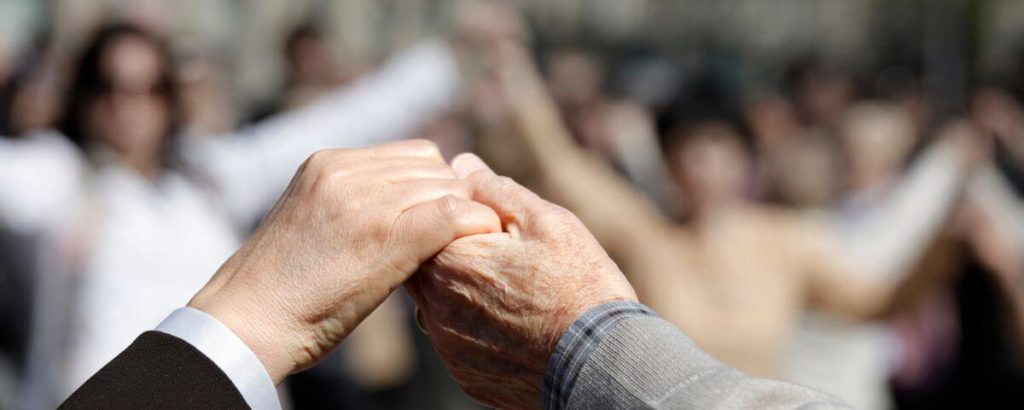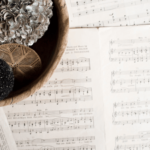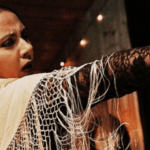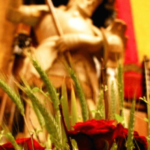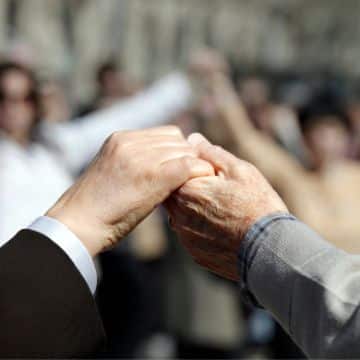
Discover the tradition of the Sardana Dance
WHAT LA SARDANA MEANS FOR CATALONIA
La Mercè, the main festival of Barcelona, is here. There’ll be plenty of events going on, and it’s a great opportunity to discover the local traditions such as castellers human castles, monster parades, correfoc fire runs and… sardana dancing!
“La Sardana és la dansa més bella de totes les danses que es fan i es desfan” – Sardana is the prettiest dance of all the dances that are done and undone. This is the beggining of a poem by Joan Maragall that summarizes the pride of Catalan people for their most traditional dance. Very simple in apparence: a circle of people holding hands and stepping to the sides, occasionally bouncing. But full of symbolism: the unity of the people.
It isn’t fiery like flamenco, nor sensual like tango, nor entertaining like salsa. But it speaks of a nation that works together, doing little things that need precision to reach a goal. In a sense, it’s almost like a community prayer.
1
Brief sardana dance history and origins
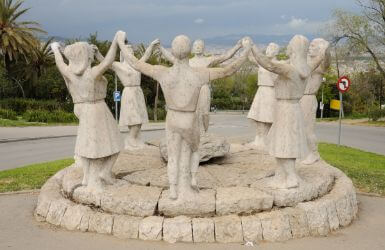
Circle dances have been documented in the Mediterranean area since time of the Ancient Greece. So the roots of the Sardana are likely to date back to those old times. However, the first written record mentioning Sardana dancing is from the 1600's, when it was danced as a form of entertainment by nobles and aristocrats, mostly in the areas that border what now is the French border near Girona. Only later on it'd be adopted by the more popular layers of the Catalan society.
The late 1800’s and early 1900’s are a moment of splendor for Barcelona. The Modernism art style (local Art Nouveau) is embellishing the city, the money is flowing thanks to the Industrial Revolution, and after a few centuries of decadence the cultural scene is blooming in the movement called “Renaixença”. The intellectual elite researches and standardizes the Catalan history, language and traditions to nurture a recovered pride for what’s local. And here is where la Sardana dance plays a key role as an authentic element of folklore with a metaphoric message of unity and local identity.
After the Spanish Civil War (1936-1939), Spain was ruled by the General Franco dictatorship, who felt any expressions of regional cultures should be anihilated, as they posed a threat to the unity of Spain. Local traditions that weren’t considered authentically Spanish were banned, along with the local languages such as Catalan, that was only allowed in private settings. That affected the Sardana dancing as well, was forbidden, even if the Catalan people managed to keep it alive under the table.
It wouldn’t be until the come back of the democracy after Franco died in 1975 that Catalans were allowed again to dance Sardana in public again, and it started being included as a key element of any local festivity and celebration, cobla bands and colles sardanistes (dancer teams) were created, “aplecs” (sardana gatherings) started being scheduled all over, and even for many years the popular Corte Ingles department store organized free lessons for kids in front of their flaghship store of Plaza Catalunya.
2
Sardana music
While there are a handful of different sardana types, the one you’ll see locals dance is the one known as “Sardana Llarga”, where each song lasts 12 – 13 minutes. Other sardana styles are less common and reserved for dance competitions or to allow the musicians to show off their skills. Also in 1993 the renowned composer Santi Arisa created a fusion style that addes rock and jazz elements to sardana music and allows the musicians to get creative with freestyle steps – that’s called Sardanova. The Transardana is another modern style that adds non-traditional instruments to the cobla bland.
The song starts with a short intro by the flabiol, known as introit or preludi. Then it continues with a series of “tirades”, a group of bars (“tiratges”) that depending on the number of measures will be danced as “curts” (short) or “llargs” (long). There’s typically 4, 7 or 10 tirades in a sardana song.
There’s often a “contrapunt” or 2-bar break played solo by the flabiol that announces the last tirada (on a 7 tirades song) or the last two (on a 10 tirades song). The music ends with the “Cop final”, a final beat that repeats the last note of the song for an emphasized eight note.
3
Sardana etiquette
La Sardana is danced in circle. It can be all-female or all-male, but when it’s mixed dancers it’s traditional to alternate male / female / male / female when possible – the female to the right of their male partner. Ideally, one person (often a female) leads – what means she’s responsible for counting the music and give hints to the rest of the group when a change of step comes.
It is OK to join a circle when the dancing has already started: but only if you know how to dance! Dancers tend to take it badly if someone joins just to goof around. And if it’s a couples-only circle, a solo dancer should abstein from joining: find someone of the opposite sex that can dance to join the circle (or join a cercle that isn’t couples-only). Or if you are several wanting to join and the circle is already big, it’s OK to create your own circle.
If you don’t know how to dance, commit to just watching. Or you can practice on the side, outside of a circle: the Sardana dance steps aren’t too complex and you are likely to pick them up within a few songs. And if you are lucky someone might come and offer to teach you!
4
How to dance sardana: basic steps
The short step consists of an alternating one “punteig” (touching the ground with the right toe), and barely holding it on the air before placing the foot back to the ground. Next the left foot steps back, to make room for the first foot to cross over. Then it all starts over with the left food going for a punteig. During curts the dancers keep their hands holding between elbow and shoulder level. The long step of Sardana dancing consists of 3 punteigs, followed by a cross over before starting again with the 3 punteigs started with the other foot instead. During the “llargs” the hands are holding between shoulder and head level.
Sardana dancers often use modified steps to end the tirades with their feet back together. They are known as dosos or tresos (or a combination of them) or a more uncommon quatre, and they are slight modifications of the classic curt and llarg steps. They are danced with the hands holding at shoulder level.
Sometimes the music enters a more beated rythm, highlighted by the double bass. The dancers interpret this change by adding a bounce to their steps. It can be a soft bounce (salt petit) when the music goes in crescendo, or a more energetic bounce that is almost like a small jump (salt fort) when the musicians go for a “tutti” (all musicians in, with a lot of emphasis). In Salt Fort the dancers will also rise their hands holding over their heads.
The contrapunt, or short break that announces the end of the song is coming, is not danced: dancers stand with their feet together and hands relaxedly holding at hip level. To mark the “cop final” (final beat), the dancers stretch their hands towards the center of the circle in one energetic final move. This is often preceeded by the leader of the dance shouting “Fora!” (Out!) to signal the end is imminent.
5
How to dress for sardana dance: shoes and more
In a “social dancing” setting, Catalans don’t dress for Sardana: just whatever you are wearing is fine, as long as it’s a comfortable outfit. But in a competition setting, dancers do dress up. The members of a “colla sardanista” (sardana team) dress in costumes inspired in the typical Catalan dresses. Mans wear simple pants and shirts, sometimes paired with a “faixa” sash. Women wear matching colors for the shirt and knee-lenght starched circle skirt. Both might wear also a handkerchief tied to their necks with the logo of their colla.
But the most important thing for sardana dancing are the shoes. It’s easier to dance wearing flats, trainers or any shoe that doesn’t have heels. But the most traditional type of sardana dance shoe are espadrilles. Purists will tell you there’s a particular type of espadrilles: white with 7 color laces. That’s not untrue, but no one will look down at you if you don’t wear that particular model. Any flat espadrille works for dancing. And even high heeled ones will make you feel more connected if you are just watching (but dancing with high heels might be tricky unless you have mastered the dance first).
6
Where to see sardana dancing in Barcelona
Sardana is danced outdoors, in main plazas and squares during local festivities. For instance, if you are visiting Barcelona around September 24 when La Merce festival is going on, sardana dancing and sardana shows are scheduled most mornings. You’ll get a chance to see sardana dancing also during the Festes de Santa Eulalia in February, or during most district Festes Majors.
People also gather together to dance Sardana in front of the Barcelona Cathedral (Plaça Nova – Pla de la Seu) every Sunday around 11.30 or noon, as well as at 6PM (but it might be later in the Summer to avoid the heat). The first one tends to attract an older crowd, while in the evening you tend to see more young adults. In any case, I strongly recommend to check the official calendar of the Confederacio Sardanista to see what’s going on during your stay. TIP: check it only a few days before your departure for the most accurate list of events, and use Google Translate because their website is in Catalan only.
Will you go watch sardana dancing while in Barcelona?
Marta
RESEARCHING FOR A TRIP IS TIME-CONSUMING…
Need more inspiration?
Our 100% FREE Barcelona Collection will give you everything you need to organize the trip of your lifetime to Barcelona.
BEST INSIDER TIPS FROM THE PROS!

Last update on 2024-04-24 / Affiliate links / Images from Amazon Product Advertising API

